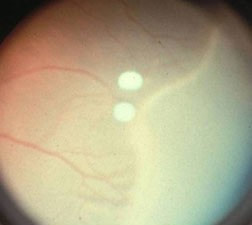Retinopathy of PrematurityWhat is Reinopathy of Prematurity (ROP)?
Retinopathy of prematurity (ROP) is an eye problem that can cause blindness and is caused by abnormal growth of blood vessels in the retina in premature infants. The retina is a part of the eye that lines the inner wall of the back of the eye and receives light and turns it into visual messages that are sent to the brain. When a baby is born prematurely, the retinal blood vessels are not full grown and can grow abnormally. Most ROP goes away without causing damage to the retina. When ROP is severe, it can cause the retina to pull away or detach from the wall of the eye and possibly cause blindness. Babies born at a weight of 1500 grams or less and born before 31 weeks gestation are at highest risk. How does ROP affect my baby?
Most babies with ROP see normally for their age. It is only when ROP gets worse to the most severe stages that vision is threatened. Fortunately, most ROP goes away without causing vision loss. The trouble is, no one can predict which babies will do well and which will develop eye problems. When ROP develops, your baby will not feel pain or look differently to you. Screening carefully and timely treatment (when needed – see below) are the most important ways to prevent vision loss from ROP. How many infants have ROP?
There are about 3.9 million infants born in the U.S. each year. About 14,000 get ROP and 90% of those with ROP have only mild disease. About 1,100- 1,500 develop ROP severe enough to need medical treatment and 400-600 infants each year in the U.S. become legally blind from ROP. What determines how bad ROP gets?
Birth weight and gestational age are the most important risk factors for getting severe ROP. Other things seen in infants with ROP include anemia, poor weight gain, blood transfusion, respiratory distress/breathing difficulties, bleeding in the brain and the overall health of the infant. Close monitoring of oxygen levels can limit how bad the ROP gets. The amount of light the baby is exposed to does not affect how bad the ROP gets.
Is optic nerve hypoplasia associated with non-visual problems?
Optic nerve hypoplasia can be associated with central nervous system (CNS) malformations which put the patient at risk for other problems, including seizure disorder and developmental delay. Certain malformation on brain magnetic resonance imaging (MRI) are highly predictive of associated hormone and developmental abnormalities such as posterior pituitary ectopia or cerebral hemispheric abnormalities. Significant hormone deficiencies occur in 15% of children with OHN, but mild hormone deficiencies occur in the majority of patients regardless of normal MRI findings. Who needs treatment for ROP?
When ROP gets bad enough, called Type 1 ROP, the risk for retinal detachment (and possible permanent vision loss) becomes great and treatment is recommended. (see below)
The second type of treatment is an injection of medication (bevacizumab, ranibizumab, and aflibercept have been used) into the eye. This medication injection stops a signal that is causing the abnormal blood vessels in ROP to form. These medications may be used as an alternative to, or in addition to, laser treatment. The injection is a newer treatment than the laser treatment. The effect of laser or injection treatment for ROP is usually good with the disappearance of abnormal blood vessels from ROP. But, even with good diagnosis and timely treatment, the ROP sometimes continues to worsen and the retina pulls away from the back of the eye (this is called a retinal detachment).
Eyes with retinal detachment caused by ROP can have very poor vision. A retinal detachment can be treated with a different type of surgery by a retina surgeon who has experience treating ROP. Despite best treatment, some eyes with ROP get worse and go on to permanent and severe vision loss. Why are eye exams recommended after discharge from the hospital?
It is VERY IMPORTANT to have eye exams after discharge from the hospital since ROP may not be gone before discharge. The timing of these exams is very important because delays in examination will delay treatment. Delay of treatment can increase the risk of vision loss from ROP since you will not be able to tell whether your baby’s ROP has gotten worse just by looking at him or her. Also, even with successful treatment of ROP, prematurity may lead to other vision problems. Prematurity is a risk factor for the development of amblyopia (lazy eye), eye movement problems (strabismus), the need for glasses (even at a young age), and cortical visual impairment. Therefore, every premature infant needs the long-term care with an ophthalmologist (Eye MD). What type of research is there on ROP?
There is a lot of research on many topics to understand better ways of screening, examining, and treating for ROP. Some research topics include:
|
A Shared Vision: Partners in Pediatric Blindness & Visual Impairment
EIN 81-4227664




